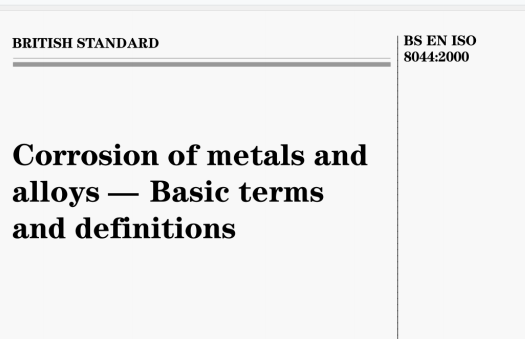ISO 8044 pdf download – Corrosion of metals and alloys- Basic terms and definitions.
3.29
fretting corrosion
process involving conjoint corrosion (2.01) and oscillatory slip between two vibrating surfaces in contact
NOTE Fretting corrosion can occur, br example, at mechanical joints In vibrating structures.
3.30
wear corrosIon
process involving conjoint corrosion (2.01) and friction between two sliding surfaces in contact
3.31
corrosion fatigue
process involving conjoint corrosion (2.01) and alternating straining of the metal, often leading to cracking
NOTE Corrosion fatigue can occur when a metal is subiected to cyclic straining in a corrosIve environment (2.03).
3.32
stress corrosion
process mvo4ving conjoint corrosion (2.01) and straining of the metal due to applied or residual stress
3.33
stress corrosion cracking
cracking due to stress corrosion (3.32)
3.34
hydrogen embrittlement
process resulting in a decrease of the toughness or ductility of a metal due to absorption of hydrogen
NOTE Hydrogen ernbritliornent otten acconipanes hy&ogen formation, bc exançle by corrosion (2.01) or electrolysis, and can lead to cracking.
3.35
blistering
process resulting in dome-shaped defect visib’e on the surface of an object and arising from localized loss of cohesion below the surface
NOTE For example, blistering can occur on coated metal due to loss of adhesion between coaling and serate, caused by accumulation of products from localized corrosion (3.10). On uncoated metal. blistering can occur due to excessive Internal hydrogen pressure.
NOTE Temporary protection is used, for example. during storage and transportation of mtal products or during shut-down of equIpment.
4.04
protective layer
layer of a substance on a metal surtace that decreases the corrosion rate (2.12)
NOTE Such layers may be appided or arise spontaneously. for example by corrosIon (2,01).
4.05
protective coating
layer(s) of material applied to a metal surlace to provide corrosion protectIon (4.01)
4.08
corrosion Inhibitor
ctiemcaI substance that when present in the corrosion system (2.04) at a suitable concentration decreases the corrosion rate (2.12). without significantly changing the concentration of any corrosive agent (2.02).
ISO 8044 pdf download – Corrosion of metals and alloys- Basic terms and definitions
